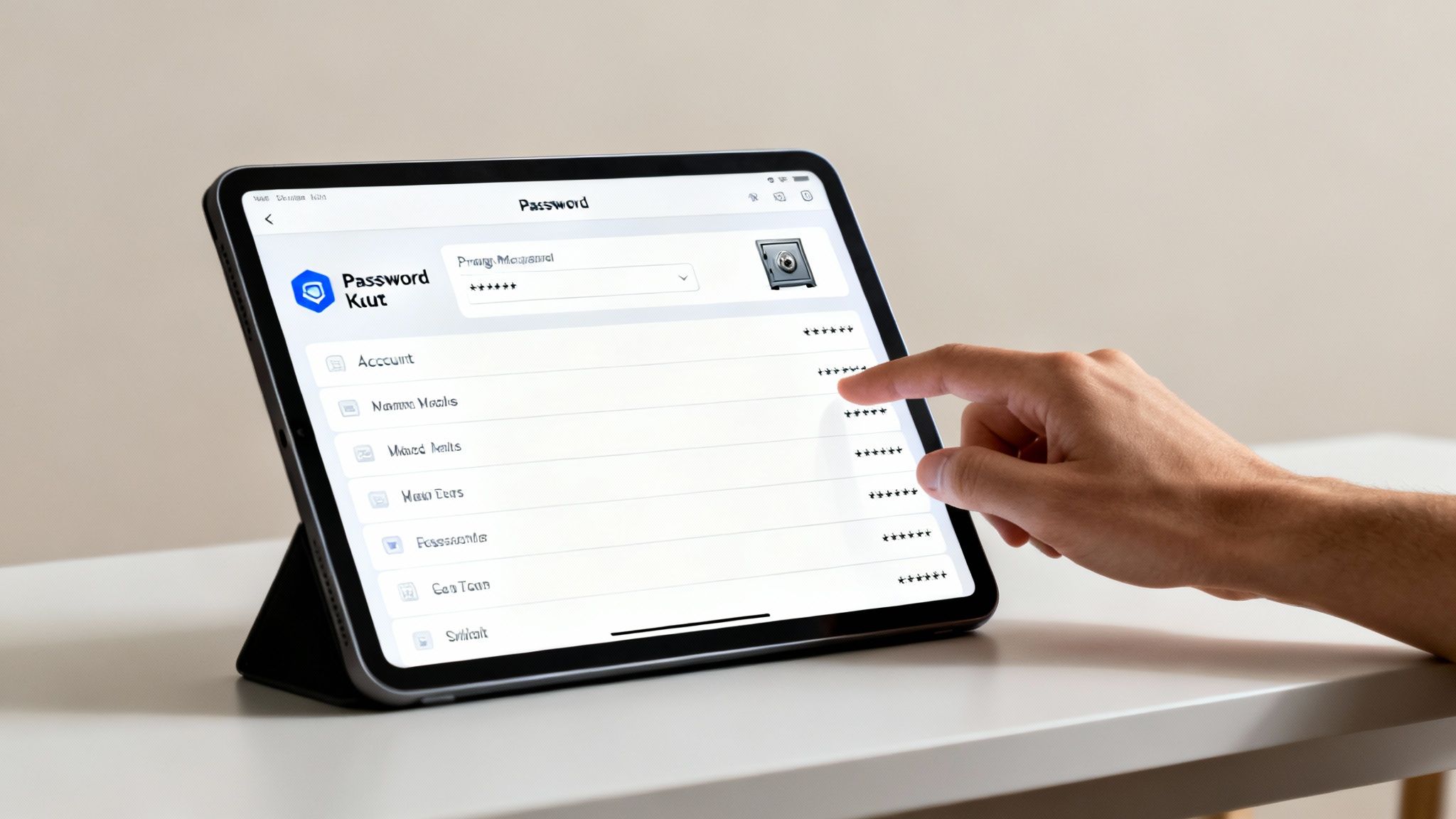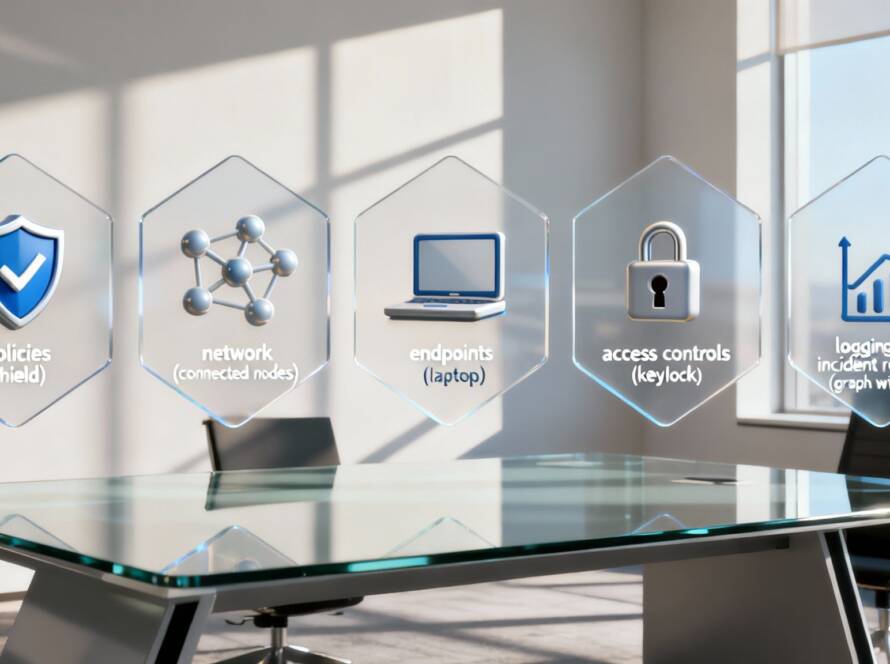In our hyper-connected world, a single weak password can be the only thing standing between your sensitive business data and a cybercriminal. From client records and financial information to proprietary systems, the strength of your digital locks has never been more critical. Yet, common mistakes like reusing credentials across services and failing to implement multi-factor authentication remain widespread, leaving significant vulnerabilities for attackers to exploit. This guide moves beyond the obvious, providing a comprehensive roundup of the top ten essential password security best practices.
This article is designed for business owners and professionals who need clear, actionable guidance. We will explore practical strategies, from creating truly unbreakable passwords and leveraging powerful security tools to implementing sound company-wide policies. You will learn not just what to do, but how to do it effectively within your organization. Whether you're securing a small home office or a growing business, these expert-backed practices provide a direct roadmap to building a formidable digital defense. Each point is structured to help you strengthen your security posture immediately, protecting your assets, reputation, and continuity. Consider this your definitive checklist for robust protection against modern digital threats.
1. Use Strong, Complex Passwords
The foundation of any robust password security best practices policy is the creation of strong, complex credentials. A strong password acts as the first line of defense, making it exponentially harder for unauthorized users to gain access through common methods like brute-force or dictionary attacks. The core principle involves creating a credential that is both long and random, avoiding any predictable patterns, personal information, or common words.

This approach is championed by organizations like the National Institute of Standards and Technology (NIST) and is a default security measure for platforms like Microsoft Azure and financial institutions. The goal is to move beyond easily guessed combinations like "Password123!" and embrace true complexity.
How to Implement Strong Passwords
For a password to be considered strong, it should adhere to several key criteria. Modern guidance prioritizes length over mandatory, complex character rules, as length is the single most important factor in resisting brute-force attacks.
- Length is Key: Aim for a minimum of 16 characters. The longer the password, the more time and computational power it takes to crack.
- Embrace Passphrases: A highly effective method, popularized by the XKCD webcomic, is to create a passphrase. String together four or five random, unrelated words, such as
CorrectHorseBatteryStaple. This creates a long, memorable, and difficult-to-guess password. - Use a Mix of Characters: While length is paramount, incorporating a mix of uppercase letters, lowercase letters, numbers, and symbols (
!@#$%^&*) adds another layer of security. - Test Its Strength: Use a reputable online tool to check your password's strength before implementing it. These tools can estimate how long it would take a computer to crack it.
2. Enable Multi-Factor Authentication (MFA)
While a strong password is a critical first defense, Multi-Factor Authentication (MFA) provides a powerful second layer of security. MFA requires users to provide two or more verification factors to gain access to a resource, effectively neutralizing the threat of a compromised password. This approach combines something you know (your password) with something you have (like a phone or security key) or something you are (a fingerprint or face scan).

This practice is one of the most effective password security best practices available. Major tech companies like Google have reported significant reductions in account hijackings after implementing MFA, and platforms such as GitHub now mandate it for code contributors. Its adoption is a core component of modern cybersecurity and is essential for protecting sensitive business and personal data.
How to Implement Multi-Factor Authentication
Implementing MFA is a straightforward process that drastically enhances security. The key is to choose the right methods and apply them consistently across all critical accounts, especially those containing sensitive information or that control password resets for other services.
- Prioritize Authenticator Apps: Use apps like Google Authenticator, Microsoft Authenticator, or Authy over SMS-based codes. App-based MFA is more secure and is not vulnerable to SIM-swapping attacks.
- Enable on Critical Accounts First: Start by securing your primary email account, as it is often the key to resetting passwords for all other services. From there, enable it on financial, social media, and business accounts.
- Consider Hardware Keys for High-Value Targets: For maximum security, use a physical hardware key like a YubiKey. These devices are nearly impossible to compromise remotely and are ideal for protecting administrator or financial accounts.
- Securely Store Backup Codes: When you set up MFA, you will be given backup codes. Print these out and store them in a secure physical location, like a safe, in case you lose access to your primary device. Learn more about how MFA fits into a comprehensive security strategy by exploring network security best practices.
3. Use a Password Manager
Relying on human memory to manage dozens of unique, complex passwords is an impossible task that often leads to password reuse or simple, weak credentials. Password managers are specialized applications that solve this problem by securely storing all your passwords in a single encrypted vault. This vault is protected by one strong master password, which is the only one you need to remember.

This approach is a cornerstone of modern password security best practices and is widely adopted by both individuals and corporations. For instance, tech giants like IBM and Slack utilize 1Password to secure employee access, while LastPass serves over 33 million users globally. These tools not only store credentials but also generate strong, random passwords for new accounts, eliminating human weakness from the creation process.
How to Implement a Password Manager
Effectively integrating a password manager involves more than just downloading an application. It requires a deliberate strategy to ensure maximum security and usability.
- Create a Strong Master Password: Your master password is the key to your entire digital kingdom. Use a long passphrase (e.g.,
BrightPurpleWagonSleepsLoudly) that is unique and not used for any other account. - Enable Multi-Factor Authentication (MFA): Add an extra layer of protection to your password manager account itself. This ensures that even if your master password is compromised, no one can access your vault without the second authentication factor.
- Use the Built-in Password Generator: When creating a new account or updating an old password, always use the manager’s built-in generator to create a long, random, and unique password.
- Conduct Regular Security Audits: Most password managers, like Dashlane and Bitwarden, offer a security audit feature. This tool identifies weak, reused, or compromised passwords in your vault, prompting you to update them immediately.
4. Never Reuse Passwords Across Accounts
One of the most critical password security best practices is to ensure every account has a unique credential. Password reuse is an incredibly common yet dangerous habit; when one online service suffers a data breach, cybercriminals take the exposed email and password combinations and test them against other popular platforms in a technique called "credential stuffing." A single breach can lead to a domino effect, compromising your email, banking, and social media accounts if they share the same password.
This principle is heavily promoted by security experts like Troy Hunt, creator of Have I Been Pwned, who has documented how billions of credentials from data breaches are used in widespread attacks. The 2020 Nintendo breach, where over 300,000 accounts were compromised due to reused passwords, serves as a stark reminder of the risks. Each unique password acts as a watertight compartment, containing a breach to a single service.
How to Eliminate Password Reuse
The goal is to completely isolate each of your digital accounts so that a compromise in one area does not threaten another. This requires a systematic approach to managing your credentials, but modern tools make it far easier than it sounds.
- Use a Password Manager: This is the most effective solution. A password manager generates, stores, and autofills a unique, complex password for every site you use, meaning you only have to remember one master password.
- Conduct a Password Audit: Systematically review your key accounts (email, financial, social media) to identify and change any reused passwords. Prioritize your most sensitive accounts first.
- Sign Up for Breach Alerts: Use a free service like Have I Been Pwned to receive notifications if your email address appears in a new data breach. This allows you to proactively change the affected password.
- Change Passwords Immediately: When you receive a breach notification from a service you use, change the password for that account and any other accounts where you might have reused it.
5. Regular Password Updates for Compromised Accounts
The era of arbitrary, calendar-based password expiration policies is over. Modern password security best practices now advocate for a more intelligent, threat-based approach: changing passwords only when there is a specific reason to believe an account may be compromised. This strategic rotation minimizes user friction while focusing resources on genuine security threats, such as a data breach or suspicious activity.
This shift is championed by leading cybersecurity authorities, including NIST, whose updated guidelines moved away from forced periodic changes. Major tech companies like Microsoft have followed suit, removing mandatory expiration from their baseline security recommendations. The new focus is on reacting to real-world threats rather than enforcing a compliance-driven, and often counterproductive, schedule.
How to Implement Threat-Based Password Updates
Implementing a reactive password update policy requires vigilance and clear protocols for when a change is necessary. The goal is to act decisively when risk is identified, not based on an arbitrary timeline.
- Act on Breach Notifications: The most critical trigger is a notification from a service provider that your data has been involved in a breach. Change the password for that service immediately, along with any other accounts where you reused the same credential.
- Monitor for Suspicious Activity: Reset passwords if you notice unusual login attempts, unexpected location alerts, or unauthorized changes to account settings. Many platforms, like Google and Facebook, will proactively alert you to such events.
- Rotate After High-Risk Sessions: If you must use a public or untrusted computer or network to access a sensitive account, change the password as soon as you are back on a secure device.
- Manage Shared Account Access: When an employee or team member with access to a shared account leaves your organization, their access should be revoked, and the shared password must be changed immediately to secure the account.
6. Avoid Sharing Passwords
A core tenet of modern password security best practices is the strict avoidance of password sharing. While it may seem convenient to share credentials for a group account, this practice fundamentally undermines security by destroying accountability, creating complex audit trails, and multiplying the risk of a breach. If a shared credential is compromised, it becomes nearly impossible to trace the source of the unauthorized access.
This principle is a cornerstone of compliance frameworks like HIPAA and PCI-DSS, which mandate individual user accounts to ensure traceability and control. Modern platforms like AWS and Facebook Business Manager are built around providing granular, role-based access, eliminating the need for users to ever share root or primary account credentials. The goal is to ensure every action can be attributed to a specific, identifiable user.
How to Implement a No-Sharing Policy
Enforcing a no-sharing policy requires providing secure alternatives for collaboration and access delegation. This shifts the focus from sharing credentials to sharing access in a controlled, revocable manner.
- Create Individual Accounts: The simplest step is to ensure every user has their own unique login for every system they need to access. This is non-negotiable for critical business applications.
- Leverage Secure Sharing Features: For situations where access must be shared, use tools designed for it. Many password managers offer secure sharing features that grant temporary or limited access to a credential without revealing the password itself.
- Use Role-Based Access Control (RBAC): Instead of sharing an administrator's login, assign specific roles and permissions to individual users. This grants them only the access they need to perform their jobs.
- Implement Single Sign-On (SSO): SSO solutions streamline access by allowing users to log in to multiple applications with a single set of credentials, managed centrally by the organization. This reduces the number of passwords an employee must manage and eliminates the temptation to share them.
- Utilize Secrets Management Tools: For technical credentials like API keys or database passwords, use dedicated secrets management tools that control and audit access for developers and automated systems.
7. Secure Password Storage and Transmission
A strong password can be rendered useless if it is not stored and transmitted securely. Proper password security best practices demand that credentials are never stored in plain text or sent over unencrypted channels. This principle protects passwords from being easily stolen during a data breach or intercepted as they travel across a network. The goal is to make the password unreadable to anyone who might gain unauthorized access to the database or network traffic.
This practice is a core tenet of cybersecurity frameworks like those from OWASP (Open Web Application Security Project). High-profile breaches, like the 2012 LinkedIn incident, exposed millions of passwords precisely because they were stored with weak, unsalted hashing algorithms. Modern systems, like those used by GitHub and 1Password, employ robust hashing and encryption methods like bcrypt and AES-256 to protect user credentials even if a breach occurs.
How to Implement Secure Storage and Transmission
Both end-users and system administrators have a role to play in ensuring passwords remain confidential. For users, this means being vigilant about how and where you enter your credentials. For developers and administrators, it means implementing strong cryptographic protections on the back end.
- For Users:
- Always Look for HTTPS: Before entering a password, ensure the website URL begins with
https://. The "s" indicates a secure, encrypted connection. - Avoid Insecure Storage: Never save passwords in plain text files, spreadsheets, or unencrypted notes. Use the secure, encrypted notes feature within a password manager for sensitive information.
- Beware of Public Wi-Fi: Avoid logging into sensitive accounts on public Wi-Fi without a VPN. An unsecured network can expose your data to interception. For more information on securing your connection, learn more about how to secure your Wi-Fi network.
- Always Look for HTTPS: Before entering a password, ensure the website URL begins with
- For Developers/Administrators:
- Use Strong Hashing Algorithms: Store user passwords using modern, adaptive hashing functions like Argon2, scrypt, or bcrypt. These require significant computational work, making them resistant to brute-force attacks.
- Always Use Salt: A "salt" is a unique, random string of data added to each password before it is hashed. Salting ensures that even identical passwords will have different hash values in the database, preventing rainbow table attacks.
- Enforce TLS/SSL: All data transmission, especially login credentials, must be encrypted using Transport Layer Security (TLS) or its predecessor, Secure Sockets Layer (SSL).
8. Implement Account Lockout and Rate Limiting
Beyond user-created credentials, server-side protections are a critical component of a comprehensive password security best practices policy. Account lockout and rate limiting are two such mechanisms that act as a powerful defense against automated brute-force attacks. These systems work by monitoring and restricting the number of failed login attempts from a specific account or IP address within a set timeframe.
This strategy is a cornerstone of guidelines from NIST and is required for PCI DSS compliance. By making rapid, repeated password guessing computationally impractical, these controls stop attackers before they can succeed. Well-known platforms like Apple iCloud, which locks an account after 10 failed attempts, and Microsoft's Active Directory demonstrate the effectiveness of this security layer.
How to Implement Account Lockout and Rate Limiting
The goal is to frustrate automated attacks without excessively inconveniencing legitimate users who may have forgotten their password. A balanced approach is key to securing your systems and maintaining a positive user experience. These controls are a fundamental part of a layered defense, bolstering your overall network security posture.
- Set a Low Threshold: Configure your system to take action after a small number of failed attempts, typically between 3 and 5. This is low enough to stop most automated scripts quickly.
- Use Progressive Delays: Instead of a permanent lockout, consider escalating time delays after each failed attempt. This can be less disruptive for legitimate users than a hard lock requiring administrator intervention.
- Implement IP-Based Limiting: As a first line of defense, limit login attempts from a single IP address. This can mitigate distributed attacks where one user account is targeted from many locations.
- Provide Clear User Messaging: When an account is locked, clearly inform the user why it happened and what steps they need to take to regain access. This prevents user confusion and reduces support requests.
9. Use Password Strength Meters and Validation
Providing users with immediate, real-time feedback is a powerful way to guide them toward creating stronger credentials. Password strength meters and validation tools analyze a potential password as it's being typed, offering a score and actionable advice. This proactive approach helps users understand the principles of password security best practices by showing them why a certain password is weak, rather than just rejecting it.
These systems move beyond simple character requirements, evaluating factors like length, character diversity, dictionary words, and common patterns. Advanced tools, such as the open-source zxcvbn library developed by Dropbox, can even estimate the time it would take to crack the password. This method transforms password creation from a frustrating chore into an educational experience, reinforcing good habits at a critical moment.
How to Implement Password Strength Meters
Effective implementation involves more than just showing a colored bar. The goal is to provide clear, helpful guidance that encourages users to create credentials that are resistant to modern threats.
- Explain the 'Why': Choose or configure a meter that provides specific feedback, such as "This is too common" or "Add another word to make it stronger."
- Check Against Breaches: The most robust systems integrate with services like the Have I Been Pwned API to instantly check a proposed password against billions of known compromised credentials. Platforms like GitHub already block passwords that have appeared in major breaches.
- Go Beyond 'Strong': Encourage users to aim for the highest possible rating, often labeled 'Very Strong' or represented by a full-strength bar. A merely 'Strong' password might still be vulnerable.
- Block Common Passwords: At a minimum, your validation system should reject passwords from a blocklist of the top 10,000 most common passwords, which are often the first ones an attacker will try.
10. Monitor for Compromised Credentials
Even the strongest passwords can be exposed in a third-party data breach, making proactive monitoring a critical component of any password security best practices policy. This process involves regularly checking specialized services that scan billions of credentials leaked in data breaches and on the dark web. If your email, username, or password appears in a known breach, these services can alert you, allowing for an immediate response before attackers exploit the information.

This approach has been popularized by security researcher Troy Hunt through his invaluable service, Have I Been Pwned. Major tech companies have also integrated this functionality into their products, with tools like Google Password Checkup, Apple iCloud Keychain, and Firefox Monitor providing automated breach notifications to millions of users, highlighting its importance in modern digital security.
How to Implement Credential Monitoring
Activating breach monitoring is often simple and provides a powerful, early-warning system against account takeover. The key is to leverage both standalone services and integrated tools to ensure comprehensive coverage across all your accounts.
- Use Breach Notification Services: Register all your primary and secondary email addresses with a trusted service like Have I Been Pwned to receive free, automated alerts if your credentials appear in a new data breach.
- Enable Password Manager Alerts: Modern password managers, including 1Password Watchtower and Dashlane's Dark Web Monitoring, automatically scan your saved credentials against breach databases and flag any compromised or reused passwords.
- Act Immediately on Alerts: If you receive a notification, immediately change the password for the affected account and any other accounts where you may have reused that same password.
- Monitor Business Domains: For businesses, specialized services can monitor your entire email domain for breached credentials, providing a crucial layer of security for employee accounts and protecting sensitive company data.
Password Security: 10 Best Practices Comparison
| Item | 🔄 Implementation Complexity | ⚡ Resource Requirements | 📊 Expected Outcomes | 💡 Ideal Use Cases | ⭐ Key Advantages |
|---|---|---|---|---|---|
| Use Strong, Complex Passwords | Medium — policy + user education | Low technical; user time; typing effort | High resistance to brute-force/dictionary attacks; long crack times for 12–16+ chars | Personal and organizational accounts where passwords remain primary protection | Widely compatible; increases attacker work factor |
| Enable Multi-Factor Authentication (MFA) | Medium — user setup and service integration | Devices/apps or hardware keys; admin configuration; possible cost | Very high reduction in account compromise (≈99.9% risk drop reported) | High-risk, admin, financial, and email accounts | Blocks access even if password is stolen |
| Use a Password Manager | Low–Medium — user adoption and admin rollout | Subscription or open-source tooling; master password; device sync | Enables unique strong passwords; reduces reuse and phishing impact | Users with many accounts; teams needing secure sharing | Generates/stores unique passwords; improves UX and security visibility |
| Never Reuse Passwords Across Accounts | High manually; Low with a manager | Requires a manager or disciplined processes | Contains breach impact; reduces credential-stuffing success | All users, especially for email, banking, and critical services | Prevents domino compromises across services |
| Regular Password Updates for Compromised Accounts | Low — event-driven policy and processes | Breach detection/monitoring; support processes | Mitigates active compromises when evidence exists; reduces unnecessary rotations | After breach alerts or suspicious activity; shared/privileged accounts | Threat-driven mitigation; avoids password fatigue from arbitrary rotations |
| Avoid Sharing Passwords | Medium — requires IAM and access controls | User accounts, RBAC/SSO/PAM tools; possible license costs | Improves accountability; reduces exposure and audit gaps | Teams, enterprises, compliance-bound environments | Enables revocation/auditing; supports compliance |
| Secure Password Storage and Transmission | High — developer and infra changes | Cryptographic libraries, CPU for hashing, TLS certs, skilled staff | Makes stolen databases and intercepted credentials far less useful | Service providers, developers, and administrators | Strong server-side protection; prevents plaintext recovery |
| Implement Account Lockout and Rate Limiting | Medium — server-side logic and tuning | Dev/Ops time, monitoring, CAPTCHA or IP reputation tools | Slows/stops automated brute-force attacks; alerts admins | Public login endpoints, high-value accounts, APIs | Practical deterrent for automated guessing attacks |
| Use Password Strength Meters and Validation | Low–Medium — integrate libraries and UX | Strength libs, breach lists, client+server checks | Fewer weak passwords created; educates users at creation time | Signup and password-change flows on websites/apps | Real-time feedback; reduces weak/default credentials |
| Monitor for Compromised Credentials | Low–Medium — subscribe/integrate monitoring | Watch services, breach feeds, alerting; possible subscriptions | Early detection of exposed credentials; enables prompt remediation | All users and orgs; security operations teams | Early warning of breaches; prioritizes password changes |
Securing Your Digital Future Starts Now
Navigating the digital landscape without a robust security strategy is like leaving the front door of your business unlocked. Throughout this guide, we've explored the foundational pillars of modern digital defense, moving beyond generic advice to provide actionable, layered strategies. Mastering these password security best practices isn't just an IT task; it's a core business function essential for protecting your sensitive data, maintaining client trust, and ensuring operational continuity.
The journey to a more secure digital presence begins with small, consistent steps. We have detailed how creating truly complex passphrases, such as Mountain-Breeze-7-Flute-Jumps!, offers exponentially more protection than simple, easily guessable passwords. We emphasized that Multi-Factor Authentication (MFA) is no longer a "nice-to-have" but a critical barrier that can thwart even a successful credential theft. Implementing a reputable password manager like Bitwarden or 1Password centralizes your defenses, eliminating the dangerous habit of reusing passwords across multiple platforms and simplifying the entire process for your team.
From Theory to Action: Your Implementation Roadmap
Adopting these principles transforms your security posture from passive to proactive. The key is to build a culture of security, not just a checklist of tasks.
- Immediate Action: The single most impactful step you can take today is to enable MFA on every critical account, from your primary email and banking portals to your cloud storage and business software.
- Systematic Rollout: Introduce a password manager to your team. Start with a small pilot group to work out any implementation kinks before deploying it company-wide. This tool is the linchpin for enforcing unique, complex passwords for every service without overwhelming your staff.
- Ongoing Vigilance: Security is not a one-time setup. Regularly monitor for compromised credentials using services like Have I Been Pwned and establish clear protocols for what to do when an account is flagged. Educate your team on the importance of not sharing passwords and using secure methods for any necessary credential transmission.
By integrating these practices, you create a formidable defense system. A complex password is your first line of defense, MFA is your second, and a password manager is the framework that holds it all together. This layered approach ensures that a single point of failure, like a leaked password, does not lead to a catastrophic breach. The value extends beyond preventing financial loss; it fortifies your professional reputation. For businesses like law firms and dental practices, where client confidentiality is paramount, demonstrating a commitment to these password security best practices is a powerful differentiator that builds and maintains trust. The time and effort invested now will pay dividends in resilience, reliability, and peace of mind for years to come. Don't wait for an incident to force your hand. The power to secure your digital future is in your hands, and the time to act is now.
Implementing a comprehensive security strategy can be complex, but you don't have to do it alone. GT Computing specializes in creating and managing robust security frameworks, including the deployment of password managers and MFA solutions, to protect your business from evolving threats.
Keep your business running without IT headaches.
GT Computing provides fast, reliable support for both residential and business clients. Whether you need network setup, data recovery, or managed IT services, we help you stay secure and productive.
Contact us today for a free consultation.
Call 203-804-3053 or email Dave@gtcomputing.com.



